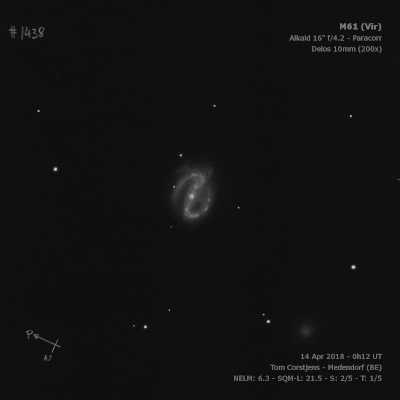
Italian astronomer Barnaba Oriani discovered M61 = NGC 4303 = H I-139 = h1202 on 5 May 1779 while observing the Comet of 1779. It was independently found by Messier the same night, though initially he mistook it for the comet, finally recognizing it was a nebula on 11 May. William Herschel found M61 on 17 Apr 1786 (sweep 553), assumed it was new, and catalogued it as I-139 with the summary description (2 observations) "eB; vBN; r, 6 or 7' dia." John Herschel observed in on 3 consecutive sweeps in 1828, describing it on 10 April as "very faintly bicentral. The two nuclei 90" distance in position angle 45 to 50° north-following." This comment was the source of the GC and NGC description "bi-nuclear" and the second nucleus is very likely the bright knot on the northern spiral arm.
Bindon Stoney discovered spiral structure on 1 Mar 1851 and noted "spiral, 2 knots, centre bright. There is another neb. 10' nf." A sketch made of M61 on 14 Apr 1852 was included in the 1861 publication, though misidentified as h1196 [NGC 4292]. The two knots clearly included in the sketch are [HK83] #91 and [HK83] #155, mentioned in my 24-inch observation. The neb 10' nf probably refers to NGC 4301 = NGC 4303A = UGC 7439. See that number.
Host of 8 supernovae since 1926 (six of these since 1961), making M61 the current record holder among Messier galaxies. The first (SN 1926A) was found by Max Wolf and Karl Reinmuth at the Heidelberg Observatory.
300/350mm - 13.1" (5/26/84): very bright, large, bright stellar nucleus. Two spiral arms are faintly visible; one arm is attached south of the nucleus and winds towards the west and then north. A slightly brighter arm is attached north of the nucleus and winds along the east side towards the south. In the field with NGC 4292 11' NW and NGC 4301 10' NE.
400/500mm - 18" (5/12/07): spiral structure was easily visible. One arm is attached at the north end and sweeps towards the northeast and then hooks to the south along the east side. A bright knot ([HK83] #91) is within the arm at the northeast end. A second broader arm is attached at the south end and sweeps towards the southwest and then hooks towards the north on the west side. The central region contains a bright, stellar nucleus.
600/800mm - 24" (5/20/20 and 5/24/20): viewed SN 2020jfo (Type II), discovered on May 6th 1.1' W and 0.5' N of the center of the galaxy. This is the 8th SN discovered in M61 since 1926, the most of any Messier. It appeared very close in brightness to a mag 14.2 star that is 1.2' W of center and collinear with another mag 14 star 2.4' SW of center.
M61 appeared strongly concentrated with a bright elongated core or bar oriented N-S that increased to an intense, very small nucleus. Three arms were easily visible. A short but well defined arm angled SW-NE on the north side (outside the eastern arm). It ended at a relatively bright HII knot [HK83] #91, which was well defined and noticed immediately. The eastern arm, which emerged from the north side of the bar, was very well defined and extended east of the core, then headed south and angled towards the southwest. The western arm began on the south or southeast side of the bar and rotated counterclockwise towards to the west and bent in the northwest direction. It past inside a 14th mag star [1.1' W of center]. A subtle brightening or knot, [HK83] #155, was seen along this arm 40" S of center (collinear with the northern knot and the center).
900/1200mm - 48" (4/5/13) and 5/1/19) at 375x and 488x, the visible structure was similar to photographic detail! A bright bar extends north-south and is sharply concentrated with a very small, round, intense nucleus. A bright arm is attached right at the north side of the bar and sweeps counterclockwise 180° to the south end, along the east side. A brighter region was visible in the arm east of the nucleus, which include HII regions NGC 4303:[HK83] #35/39/41/45/49, from the Hodge-Kennicutt "Atlas of H II regions in 125 galaxies". At this location, the arm has a sharp turn [63°] and angles towards the SW. The arm dims rapidly on the south end, but I was able to follow it much further SW in the outer halo, where it passes just north of a mag 14.0 star [2.4' SW of center].
The western arm is attached at the southern end of the bar and sweeps north on the west side. A bright, elongated patch is on the southern end of this arm, which includes [HK83] #155, ~45" SSW of the nucleus. The arm extends inside a mag 14 star in the west side of the halo [1.2' WSW of center] and then sharply dims but extends towards #242, a nearly detached faint knot 1.2' WNW of center.
A partial outer arm, not attached to the core, was easily visible on the north side, angling southwest to northeast. At the NE end of this short bright arm is the HII knot [HK83] #91, a very bright, 15" knot, 1.2' NNE of center. The arm dims suddenly on the northeast end but a diffuse extension continues to wrap counterclockwise to the southeast at the edge of the eastern halo.
Notes by Steve Gottlieb